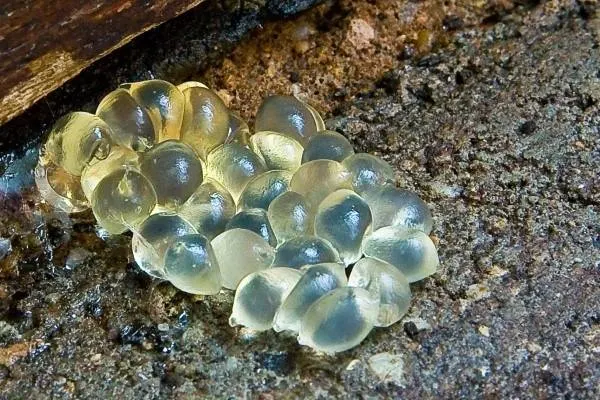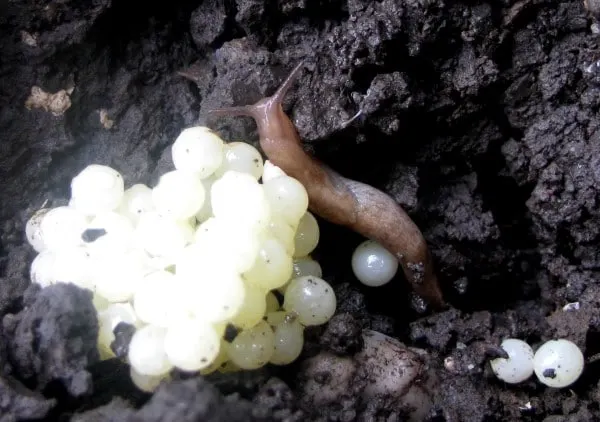Slugs are small, slow-moving creatures with no legs and a long soft body, like snails without a shell. Nothing is more boring than planting and caring for plants, only to find huge holes in one morning eaten by slugs.
It would be best if you were forgiven for all curses and expletives, which might break out from you because this is perfectly justified.
What do slug eggs look like? Slug restriction in your garden begins with identifying their eggs, knowing what slug eggs are, and finding out how to eliminate them.

What Do Slug Eggs Look Like?
Slug eggs are small jelly balls stuck together in the slimy gum. Typically, they can be grey, brown, white, pearl, yellow, or even slightly transparent.
Eggs are found in moist, dark places, like under the leaf litter, on the ground, or under lower leaves. They are sometimes laid on the vegetation but are often more difficult to spot when on the soil.
How To Identify Slug Eggs?
1. Search them at night
Slugs are seen at night and rarely come out during the day. They look for food in the dark, which is the right time to get them. During the day, slugs hide under the hollow tree trunks or rocks.
They can also be found under certain leaves. Slugs look for moist, dark, or shady places, and you can search for them in chilly places as they hate heat. These areas become the best place to see the slug eggs.
2. Monitor the common places for slugs
Slugs live in different places because the environment is promising. They generally prefer to live in damp and shaded places. If there is no shady area, they are under hard objects.
This is where you will get their eggs. Also, slugs like to stay cool, avoiding places in direct sunlight. Other places can be in the flowerpot, rocks, under different shadows, under the leaves, containers, debris, under boards and mulch, or any moist areas.
3. Identify the slime trail
If you have trouble finding the slug eggs, consider identifying their slime trails. This means you need to follow the streak to get them. The slime trail is easier to find than getting slugs themselves.
4. Deceive slugs

Slugs are hard to find because they normally hide in dark and moist places. However, luring them by creating the ideal habitats will make it easy to identify their eggs.
This will be to identify the slug house. As already mentioned, they are found in shady and cool areas. Water the place in the evening or afternoon. Moisten the soil by leaving a drop or two of water on the leaves or the leaves below.
Go back at night with a light device. Slugs will be visible. If you can’t find the slugs, you can create an artificial habitat.
To create the hiding place, you need to create a moist spot with enough shade, such as flower pots, bricks, lay woods, and stones. This way, it will be easy to identify the slug eggs.
5. Pitfall traps
These traps are the perfect place to get slug eggs. To do this, you must follow these steps:
- Dig a wide and deep hole in the soil
- Mix baking yeast or beer with water and sugar in a pitfall. Do not add much water. Else, the slugs can be drowned.
- If you have created the pitfall trap, now you are required to monitor it frequently. You need to check it not less than once a day.
Can The Slugs Fertilize Their Eggs?
Slugs are normally hermaphrodites, which means they have female and male reproductive organs. Due to hermaphroditism, slugs can fertilize their eggs if necessary. Typically, both male and female mate to produce hereditary variation and spread the species, producing fertilized eggs.
However, if there are no slugs to breed, this little slug can still bring you a lot of trouble. You can still produce many tiny slugs in your garden.
Typically, slugs lay about five hundred eggs or more during the season. You can understand why the slug problem can become out of hand quickly.
How Do I Know If Slugs Are Harming The Plants?
The leaves will have irregular holes, the seedlings won’t have any leaves but only the stem remaining. Slugs destroy the vegetables.
Another indication that you have the slug problem is if you see traces of slime trails on the plants and in the soil surrounding. Seeing the damage caused by slugs to the plants will make you the determined slug exterminator.
How To Get Rid Of Slug Eggs
Manual slug egg removal is a tedious task as you have to play detective and then find every one of those pesky balls. If there is no other choice, you must find and destroy all eggs.
The easiest way to destroy these eggs is by crushing them using wood or using a heel of the garden boot. If the eggs are on the ground, be sure to destroy them. Squeezing the eggs can only push them deeper into the soil, where they can stay secure and moist until they hatch.
If you own a chicken, use the chickens to search and eat the eggs of the slugs. Chickens are proficient and effective at recognizing slug eggs and will eat them as food.
Another animal that loves eating these eggs is fish. Essentially, if you have fish, you can collect the eggs into a spoon and then sprinkle them into the fishpond water.
You may be overwhelmed by how many eggs and if you don’t keep the poultry. Don’t despair, and you can sprinkle large amounts of diatomaceous earth on your flower bed to deal with these eggs.
Essentially, diatomaceous earth has rough, sharp pieces that cut through the eggs and absorb moisture to kill the baby slugs inside the eggs.
Conclusion
Slugs are deceptive creatures that do a lot of damage in gardens. Their eggs are irregular, round or oblong jelly-like balls usually laid in clusters. Eggs are wrapped in a thick rubber, which protects them.
They are found in warm and moist environments in the ground or under vegetation. Normally, it is important to remove the slug eggs and end the next slugs’ generation that can destroy the plants in your garden.
